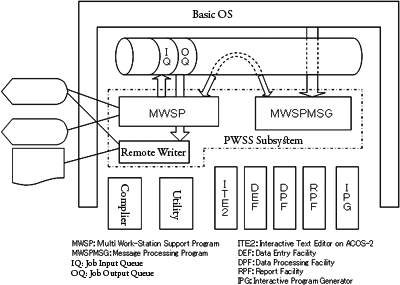NEC announced ACOS-2 in May 1974 and started shipping it in September of the same year.
ACOS-2 covered ACOS System models 200 and 250 as an operating system for small computer systems, and its design concept was to meet user needs in the field of small machines or, in other word to satisfy the demand for ease of use.
Features of its major functions included:
(1) Environment for Execution of Various Jobs and High Level of Maintainability
A multiprogramming function enabled flexible job execution through combinations of batch processing, communication processing and output writer processing. The OS also had high throughput due to spooling to the printer output. In addition, the OS had a high level of maintainability for elements fundamental to the system, such as the ability to perform system reconfiguration through automatic retry and degeneration by detecting errors due to hardware or software malfunction.
A multiprogramming function enabled flexible job execution through combinations of batch processing, communication processing and output writer processing. The OS also had high throughput due to spooling to the printer output. In addition, the OS had a high level of maintainability for elements fundamental to the system, such as the ability to perform system reconfiguration through automatic retry and degeneration by detecting errors due to hardware or software malfunction.
(2) Automation/Laborsaving Functions
Oriented toward automatic/laborsaving operation, the OS was equipped with functions such as those for automatic power on/off, automatic system startup/stop, automatic execution of reservation operation, job networking, and one-button operation from the operation panel, as well as a data-driven function for linkage between a data medium and a business program.
Oriented toward automatic/laborsaving operation, the OS was equipped with functions such as those for automatic power on/off, automatic system startup/stop, automatic execution of reservation operation, job networking, and one-button operation from the operation panel, as well as a data-driven function for linkage between a data medium and a business program.
(3) Interactive Processing System PWSS (allowed access to the computer for business operations sites)
The PWSS (Personal Work Station System) was capable of selecting and executing a business operation from a workstation and creating a business program in an interactive manner.
The PWSS (Personal Work Station System) was capable of selecting and executing a business operation from a workstation and creating a business program in an interactive manner.
- Both workstations directly connected to the system and line-connected workstations had exactly the same functions and operability.
- Had various interactive utilities for end users, and provided an interactive creation language in addition to data inputting, file updating/reference, report creation and text editing.
- Equipped with a mailing function for exchanging messages between workstations and between the system and workstations.
(4) Japanese-language Information Processing System (incorporated Japanese-language characteristics into the system by standardizing and systematizing them)
The OS enabled the user to freely use kanji as ideographic characters and kana as phonographic characters. It met the needs of the times as a familiar tool for using the Japanese language through: operation in Japanese of a Japanese dictionary creation/maintenance program and a routine for accessing the dictionary, a management program of format-overlay information and printing control information for controlling the output to a Japanese-language printer and an interactive processing system or a database system; creation of a Japanese-language processing program with a high-level language; provision of application software for Japanese-language processing; and utilization of a Japanese-language processing terminal and a Japanese-language printer.
The OS enabled the user to freely use kanji as ideographic characters and kana as phonographic characters. It met the needs of the times as a familiar tool for using the Japanese language through: operation in Japanese of a Japanese dictionary creation/maintenance program and a routine for accessing the dictionary, a management program of format-overlay information and printing control information for controlling the output to a Japanese-language printer and an interactive processing system or a database system; creation of a Japanese-language processing program with a high-level language; provision of application software for Japanese-language processing; and utilization of a Japanese-language processing terminal and a Japanese-language printer.
(5) Network System
As a central system that constituted NEC’s network architecture DINA (Distributed Information-processing Network Architecture), it served as a subordinate station for a medium-sized or large computer, a primary station for terminals or an office computer, or a relay node positioned between them. It also achieved a control pass-through function that enabled a terminal connected with ACOS-2 to be viewed as a terminal of a computer connected above ACOS-2, and an RJE (Remote Job Entry) function for effectively using the ability and resources of a medium-sized or large computer.
(6) Database SystemAs a central system that constituted NEC’s network architecture DINA (Distributed Information-processing Network Architecture), it served as a subordinate station for a medium-sized or large computer, a primary station for terminals or an office computer, or a relay node positioned between them. It also achieved a control pass-through function that enabled a terminal connected with ACOS-2 to be viewed as a terminal of a computer connected above ACOS-2, and an RJE (Remote Job Entry) function for effectively using the ability and resources of a medium-sized or large computer.
As a database suitable for small computers, it provided flexible accessibility through addition of a search function to a CODASYL type database, and was equipped with utility programs from the early stage of development, in order to promote standardization of introduction and establishment and allow user programs to be created with minimal effort. In addition, it took into account automation of maintenance, simplification of recovery processing and sufficient performance for online processing as a database oriented toward DB/DC (Data Base/Data Communication). It provided various design/analysis systems using an integrated CAE system.


